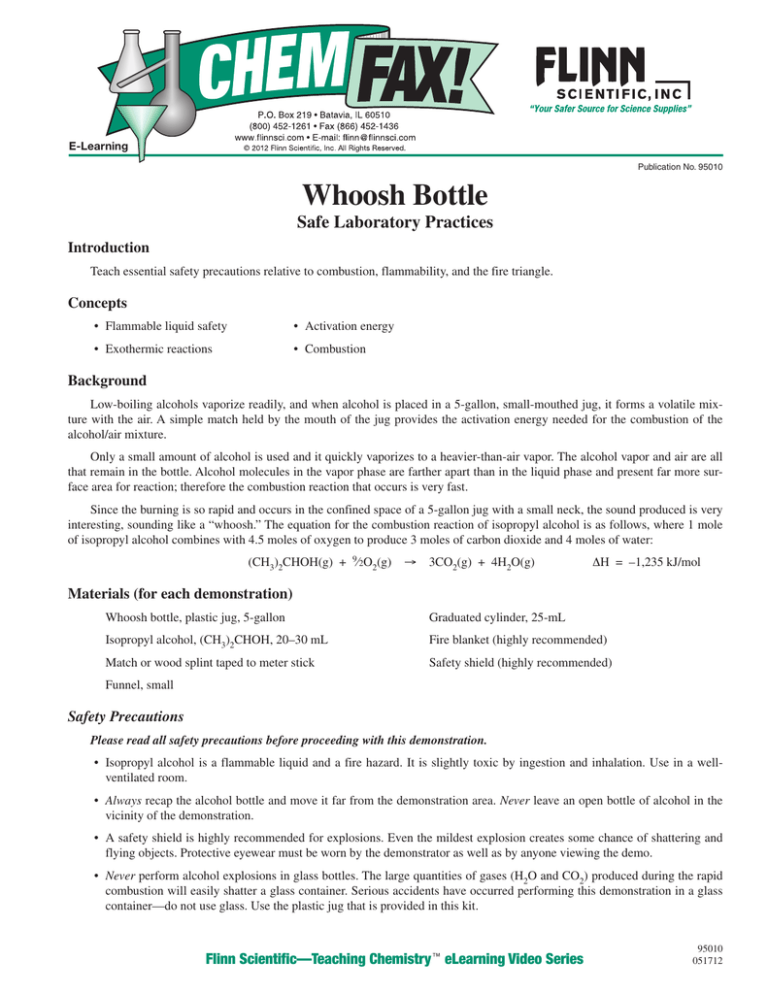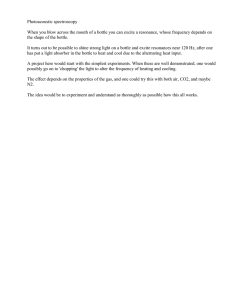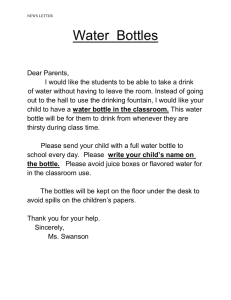
E-Learning
Publication No. 95010
Whoosh Bottle
Safe Laboratory Practices
Introduction
Teach essential safety precautions relative to combustion, flammability, and the fire triangle.
Concepts
• Flammable liquid safety
• Activation energy
• Exothermic reactions
• Combustion
Background
Low-boiling alcohols vaporize readily, and when alcohol is placed in a 5-gallon, small-mouthed jug, it forms a volatile mixture with the air. A simple match held by the mouth of the jug provides the activation energy needed for the combustion of the
alcohol/air mixture.
Only a small amount of alcohol is used and it quickly vaporizes to a heavier-than-air vapor. The alcohol vapor and air are all
that remain in the bottle. Alcohol molecules in the vapor phase are farther apart than in the liquid phase and present far more surface area for reaction; therefore the combustion reaction that occurs is very fast.
Since the burning is so rapid and occurs in the confined space of a 5-gallon jug with a small neck, the sound produced is very
interesting, sounding like a “whoosh.” The equation for the combustion reaction of isopropyl alcohol is as follows, where 1 mole
of isopropyl alcohol combines with 4.5 moles of oxygen to produce 3 moles of carbon dioxide and 4 moles of water:
(CH3)2CHOH(g) + 9⁄2O2(g) → 3CO2(g) + 4H2O(g)
∆H = –1,235 kJ/mol
Materials (for each demonstration)
Whoosh bottle, plastic jug, 5-gallon
Graduated cylinder, 25-mL
Isopropyl alcohol, (CH3)2CHOH, 20–30 mL
Fire blanket (highly recommended)
Match or wood splint taped to meter stick
Safety shield (highly recommended)
Funnel, small
Safety Precautions
Please read all safety precautions before proceeding with this demonstration.
• Isopropyl alcohol is a flammable liquid and a fire hazard. It is slightly toxic by ingestion and inhalation. Use in a wellventilated room.
• Always recap the alcohol bottle and move it far from the demonstration area. Never leave an open bottle of alcohol in the
vicinity of the demonstration.
• A safety shield is highly recommended for explosions. Even the mildest explosion creates some chance of shattering and
flying objects. Protective eyewear must be worn by the demonstrator as well as by anyone viewing the demo.
• Never perform alcohol explosions in glass bottles. The large quantities of gases (H2O and CO2) produced during the rapid
combustion will easily shatter a glass container. Serious accidents have occurred performing this demonstration in a glass
container—do not use glass. Use the plastic jug that is provided in this kit.
Flinn Scientific—Teaching Chemistry eLearning Video Series
95010
051712
• Always pour out excess unvolatilized liquid alcohol from the plastic jug before igniting. If any liquid alcohol is left, it will
increase the amount of gaseous afterburning. The liquid could also ignite, which may cause the plastic jug to melt. Always
keep a lid or some sort of cover handy, which can be placed over the mouth of the jug to extinguish the flame if it continues so long as to begin melting the plastic. Excess alcohol on the outside of the jug should be wiped off in order to avoid
its igniting and softening the plastic jug.
• Never, ever use a pure oxygen environment as the potential for an extremely violent and deadly explosion is possible.
• Never use methyl alcohol for this demonstration. The high volatility of methyl alcohol means that it has the potential for
the most violent combustion of any alcohol.
• Replace the plastic “whoosh bottle” should it show grazing, frosting, cracking, or any small flaws. Routinely replace the
bottle after approximately 20 uses or so.
• Do not perform this demonstration directly underneath smoke/heat detectors or sprinkler systems.
• Make sure the ceiling is at least 4 feet above the whoosh bottle to prevent possible scorching and fire.
• Always wear protective eyewear when performing this demonstration. Please consult current Material Safety Data Sheets
for additional safety information on isopropyl alcohol.
Preparation
Before each demonstration, inspect the plastic whoosh bottle for grazing, frosting, cracking, or any small flaws. Replace the
bottle if it shows signs of fatigue.
Procedure
1. Add about 20–30 mL of isopropyl alcohol to the 5-gallon plastic jug. Do not add more than 30 mL of alcohol. Recap the
bottle of alcohol tightly and move it far from the demonstration area.
2. Lay the jug sideways on a flat surface allowing the alcohol to flow from base to mouth. Slowly swirl the jug for about 30
seconds, trying to spread alcohol liquid completely over the entire interior surface. This allows the liquid alcohol to volatilize and makes the vapor concentration uniform throughout the bottle. If a lot of liquid alcohol is still visible, swirl the
bottle for another 30 seconds.
3. Pour out any excess liquid alcohol and shake out the bottle. Wipe the inside and outside neck of the bottle to remove any
remaining liquid.
4. Stand the jug on the floor, placing it in the front of the room and behind a safety shield. Note: If desired, the demonstration
can be performed on a fireproof demonstration table provided that the ceilings are at least 10 feet high.
5. Dim the lights in the room.
6. Light a match or wood splint that is taped to a meter stick or other long stick.
7. Stand back and, at arm’s length, bring the burning match or wood splint over or slightly down into the mouth of the bottle.
Note: Be sure you are on the safe side of the safety shield as well.
8. Observe the explosive “whoosh” that results.
9. After the reaction has subsided and all the flames are out, wait for a minute or two until the bottle has cooled slightly. Pour
out the water droplets from the bottle into a 25-mL graduated cylinder using a small funnel. As much as 12–14 mL of
water may result, showing that water is one of the products of the combustion of alcohol.
Repeating the Demonstration
The demonstration cannot be repeated immediately for a few reasons—for one, the demonstration will not work due to the
buildup of CO2 in the bottle. There is not enough oxygen in the bottle to allow combustion to occur. More importantly, it can be
extremely dangerous to add alcohol to the jug if the jug is still hot. A flash back can occur causing a fire.
Therefore, in order to successfully repeat the demonstration for the same class or another class, follow the steps below:
1. Allow the bottle to cool to room temperature.
2. Pour out the water that forms as a result of the combustion.
–2–
© 2012 Flinn Scientific, Inc. All Rights Reserved.
95010
3. Fill the bottle with about 1 of cold tap water and swirl the tap water around in the bottle. Pour the tap water into the sink,
and repeat the washing with more cold tap water. Pour all the water out into the sink.
4. Dry out the bottle as much as possible by either allowing it to sit upside down or (to speed up the drying) by drying it with
a long string of paper towels pushed into the mouth. A few water droplets on the inside of the bottle do not seem to hinder
the combustion.
5. In order to reduce the amount of water in the bottle and speed up the drying, try a double rinse of the bottle with a small
amount of isopropyl alcohol.
6. Follow the procedure steps 1–9 above.
Disposal
Please consult your current Flinn Scientific Catalog/Reference Manual for general guidelines and specific procedures governing the disposal of laboratory waste. Excess alcohol may be disposed of by allowing it to evaporate in a fume hood according to
Flinn Suggested Disposal Method #18a. Before storing the jug, allow it to remain open to the air to allow any remaining vapors to
be released.
Observable Effects
The first effect that may be observed is the usual “whoosh,” which involves a moderately violent thrust of flames and blue gas
out of the mouth of the bottle. Some afterburning or dancing flames of burning vapor in the body of the bottle may also result.
The second effect is a slower burn of gas down the inside surface of the bottle, producing a ring, plate, or cone of fire, which
may be accompanied by an upward thrust or ball of yellow flames in the center of the jug. The sound accompanying these slower
burns is actually more of a “whomp.” This effect can also be observed by using 70% isopropyl alcohol, illustrating reduced vapor
pressure due to dilution.
Tips
• The use of isopropyl alcohol is recommended for safety reasons. The combustion of ethyl alcohol proceeds somewhat
faster and more violently due to its higher volatility. Propyl alcohol burns slower producing more heat, which may damage
the bottle. Do not do this demonstration with methyl alcohol. The high volatility of methyl alcohol means that it has the
potential for the most violent combustion and possible rupture of the bottle.
• Depending on how much alcohol vapor is in the bottle, you may have to place the flame slightly inside the lip of the
whoosh bottle to ignite the vapor.
• The demonstration works best if the alcohol vapor is prepared immediately before the demonstration. If the bottle with the
vapor sits for a while, the vapor tends to settle and is harder to light.
• Reagent isopropyl alcohol (99%) or 70% isopropyl alcohol can be used for the demonstration. Using 70% alcohol produces a slightly slower burn due to the water vapor.
• Use a graduated cylinder to measure the volume of water produced by the reaction. Students can calculate the volume of
water expected based on the initial amount of isopropyl alcohol added to the bottle.
For example, if 20 mL of isopropyl alcohol (density = 0.78 g/mL) are used:
20 mL × 0.78 g/mL = 15.6 g × 1 mole/60 g = 0.26 mol isopropyl alcohol
From the balanced equation,
0.26 mol isopropyl alcohol × 4 mol H2O/1 mol isopropyl alcohol = 1.04 mol H2O
Thus,
1.04 mol H2O × 18 g/mol = 18.7 g = 18.7 mL of H2O expected
–3–
© 2012 Flinn Scientific, Inc. All Rights Reserved.
95010
Connecting to the National Standards
This laboratory activity relates to the following National Science Education Standards (1996):
Unifying Concepts and Processes: Grades K–12
Evidence, models, and explanation
Content Standards: Grades 5–8
Content Standard B: Physical Science, properties and changes of properties in matter, transfer of energy
Content Standards: Grades 9–12
Content Standard B: Physical Science, structure and properties of matter, chemical reactions, interactions of energy and
matter
Answers to Worksheet Questions
1. Describe what happened in this demonstration.
A small amount of isopropyl alcohol was used to coat the inside of a large plastic jug. A light wood splint was held over
the jug with a meter stick. The isopropyl alchol ignited, causing an explosive “whoosh” sound accompanied by flames
jumping out of the mouth of the jug. Some flames could be seen afterward in the bottle. Also, flames inside the jug thrust
upward and around, making a “whomp” sound.
2. Write a balanced chemical equation for the combustion of isopropyl alcohol.
(CH3)2CHOH(g) + 9/2O2(g) → 3CO2(g) + 4H2O (g)
3. Calculate the volume of water you would expect to be produced by this reaction if 20 mL of isopropyl alcohol with a density of 0.78 g/mL were used.
20 mL × 0.78 g/mL = 15.6 g × 1 mole/60 g = 0.26 mol isopropyl alcohol
From the balanced equation, we know that 1 mol isopropyl alcohol = 4 mol water.
Therefore, 0.26 mol isopropyl alcohol × 4 mol H2O/1 mol isopropyl alcohol = 1.04 mol H2O
1.04 mol H2O × 18 g/mol = 18.7 mL of H2O expected.
4. Why does this reaction occur faster when the alcohol is in the vapor phase rather than the liquid phase?
Alcohol molecules that are in the vapor phase combust faster than molecules in the liquid phase because they are spread
further apart in the container. They therefore have a much greater surface area for the reaction, and this increased surface
area allows for more molecules to react immediately with oxygen in the air.
Reference
Fortman, J. J.; Rush, A. C.; Stamper, J. E. J. Chem. Ed. 1999, 76, 1092–1093.
Flinn Scientific—Teaching Chemistry™ eLearning Video Series
A video of the Whoosh Bottle activity, presented by Irene Cesa, is available in Safe Laboratory Practices, part of the Flinn
Scientific—Teaching Chemistry eLearning Video Series.
Materials for Whoosh Bottle are available from Flinn Scientific, Inc.
Materials required to perform this activity are available in the Whoosh Bottle—Chemical Demonstration Kit available from
Flinn Scientific. Materials may also be purchased separately.
Catalog No.
AP5943
SE225
I0019
Description
Whoosh Bottle—Chemical Demonstration Kit
Safety shield, 30 × 16
Isopropyl alcohol, 500 mL
Consult your Flinn Scientific Catalog/Reference Manual for current prices.
–4–
© 2012 Flinn Scientific, Inc. All Rights Reserved.
95010
Whoosh Bottle Worksheet
Discussion Questions
1. Describe what happened in this demonstration.
2. Write a balanced chemical equation for the combustion of isopropyl alcohol.
3. Calculate the volume of water you would expect to be produced by this reaction using the equation above. Remember,
20 mL of isopropyl alcohol with a density of 0.78 g/mL were used.
4. Why does this reaction occur faster when the alcohol is in the vapor phase rather than the liquid phase?
95010
© 2012 Flinn Scientific, Inc. All Rights Reserved. Reproduction permission is granted only to science teachers who have purchased Safe Laboratory Practices in the Flinn Scientific—Teaching
Chemistry™ eLearning Video Series. No part of this material may be reproduced or transmitted in any form or by any means, electronic or mechanical, including, but not limited to photocopy, recording, or any information storage and retrieval system, without permission in writing from Flinn Scientific, Inc.



